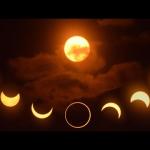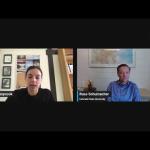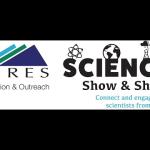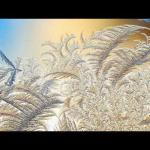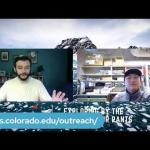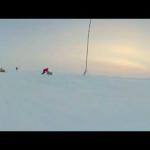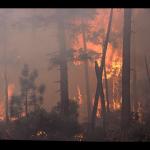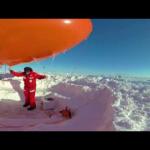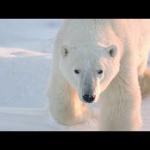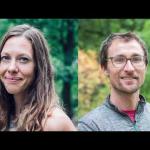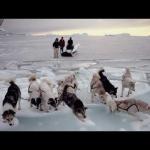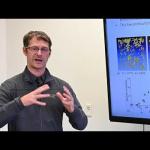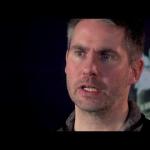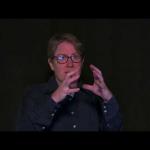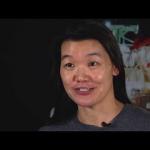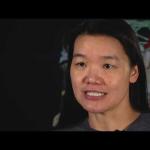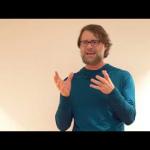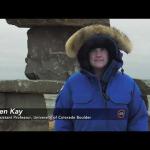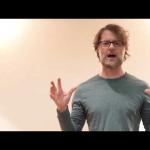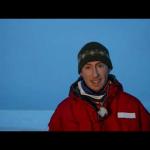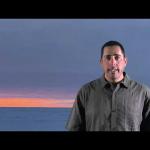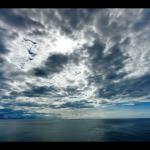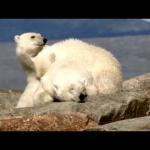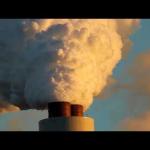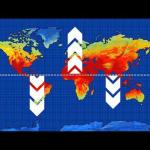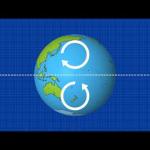Earth Science Stories
In honor of the April 8th, 2024 total solar eclipse event, the NOAA Science On a Sphere program has developed datasets showing cloud cover potential, eclipse paths, and a narrated movie describing the total eclipse phenomenon.
Recorded Science Talks
Science Show and Share
Discover the intricate web of climate, drought, and climate change in the Southwestern US in this engaging 25-minute talk and 20-minute LIVE Q&A. Our seasoned climatologist, Russ Schumacher, will explore Colorado's climate, the significance of mountain snowpack, and the path of water to rivers. Uncover key climate metrics like temperature and precipitation and their impact on water resources. Explore the diverse nature of drought, its definitions, and its evolving face under the influence of climate change.
Recorded Science Talks
Science Show and Share
Join Daniela Pennycook from the Cooperative Institute of Research in Environmental Sciences, Dr. Mimi Hugues, Research Meteorologist at the National Oceanic and Atmospheric Administration, and Andy Anderson, Forecaster at the Sierra Nevada Avalanche Center in this special webinar on Atmospheric Rivers, learn all about what they are, how we measure them, and the impact this environmental phenomenon has had on the U.S. in 2023.
Science Show and Share
This webinar is part of a 4-part series on life at McMurdo Station, Antarctica. Watch this stand-alone video on seasons in the polar regions or watch all four webinars.
Recorded Science Talks
Science Show and Share
This webinar is part of a four-part series on life at McMurdo Station, Antarctica. Watch this stand-alone video on the upper atmosphere or watch all four webinar recordings.
Recorded Science Talks
Science Show and Share
This webinar is part of a 4-part series on life at McMurdo Station, Antarctica. Watch this stand-alone video on seasons in the polar regions or watch all four webinars.
Recorded Science Talks
Science Show and Share
This webinar is part of a four-part series on life at McMurdo Station, Antarctica. Watch this stand-alone video on the upper atmosphere or watch all four webinar recordings.
Recorded Science Talks
Science Show and Share
In this stand-alone webinar, Dr. Rosimar Rios-Berrios presented on her research in hurricanes, cyclones, and forecasting.
Science Show and Share
Este video es parte de la serie Ciencia en casa y se puede ver como un seminario web independiente.
Science Show and Share
Watch MOSAiC researchers work near a meteorological tower on Arctic sea ice in this 360-degree video experience. Click and drag for a full 360-degree view!
Virtual Field Trip
In this stand-alone webinar, Joshua (Shuka) Schwarz is a research scientist in NOAA's Chemical Science Laboratory, talks about wildfire, crop burning smoke, and what it's like to be a scientist.
Science Show and Share
Watch as scientists climb a meteorological tower on the ice to repair instruments that collect atmospheric data during the 2019-2020 MOSAiC research expedition. Click and drag for a full 360-degree view!
Virtual Field Trip
In this 360-degree video, scientists park a large weather balloon nicknamed "Miss Piggy" in a tent during the 2019-2020 MOSAiC Arctic research expedition. Click and drag for a full 360-degree view!
Virtual Field Trip
This video is part of a collection - “Frozen in the Ice: Exploring the Arctic." Check out the MOSAiC page for more details.
In this specific lesson, Dr. Jeff Bowman touches on differences between the adaptive strategies of warm vs. cold-bodied organisms. You'll learn about homeostasis and thermal equilibrium as they relate to the harsh Arctic environment.
Science Content Video
This video is part of a collection - “Frozen in the Ice: Exploring the Arctic." Check out the MOSAiC page for more details.
In this video, Drs. Anne Gold and Matthew Shupe conclude the series "Frozen in the Ice: Exploring the Arctic" with a summary of the course's major lessons.
Science Content Video
This video is part of a collection - “Frozen in the Ice: Exploring the Arctic." Check out the MOSAiC page for more details.
In this specific lesson, Dr. James Overland discusses how sea ice loss can cause major changes in the Arctic climate — and more specifically, in the polar jet stream.
Science Content Video
This video is part of a collection - “Frozen in the Ice: Exploring the Arctic." Check out the MOSAiC page for more details.
In this specific lesson, Dr. John Walsh discusses how climate change is apparent throughout the Arctic (air, land, ice, and ocean) and that these changes are already impacting humans, wildlife, and the environment.
Science Content Video
This video is part of a collection - “Frozen in the Ice: Exploring the Arctic." Check out the MOSAiC page for more details.
In this specific lesson, Dr. Jessie Creamean discusses how aerosols affect clouds and precipitation in the atmosphere and why they're important to the Arctic.
Science Content Video
This video is part of a collection - “Frozen in the Ice: Exploring the Arctic." Check out the MOSAiC page for more details.
In this specific lesson, Dr. Clara Hoppe sheds light on the small but mighty phytoplankton! You'll learn about MOSAiC's special interest in primary production, carbon export, and groundbreaking data scientists expect to glean from the expedition.
Science Content Video
This video is part of a collection - “Frozen in the Ice: Exploring the Arctic." Check out the MOSAiC page for more details.
In this specific lesson, Dr. Jeff Bowman will teach you about metabolic challenges and opportunities present for organisms living in Arctic sea ice.
Science Content Video
This video is part of a collection - “Frozen in the Ice: Exploring the Arctic." Check out the MOSAiC page for more details.
In this specific lesson, Dr. Marcel Nicolaus describes his role as MOSAiC's sea ice team leader and why their work is so crucial to the expedition. In studying sea ice, snow, and microorganism habitats, the team hopes to improve Arctic forecasts and better understand how drifting patterns/processes interact.
Science Content Video
This video is part of a collection - “Frozen in the Ice: Exploring the Arctic." Check out the MOSAiC page for more details.
In this specific lesson, Dr. Jennifer Hutchings defines sea ice kinetics. Throughout the MOSAiC expedition, scientists will be monitoring the kinematics of ice motion and determining the forces involved in opening, shearing, and closing sea ice.
Science Content Video
This video is part of a collection - “Frozen in the Ice: Exploring the Arctic." Check out the MOSAiC page for more details.
In this specific lesson, Dr. Allison Fong discusses Arctic ice melt and what this means for the surrounding biological environment. You'll ponder the question: Will the Arctic be net primary productive or will it ultimately be a source of carbon?
Science Content Video
This video is part of a collection - “Frozen in the Ice: Exploring the Arctic." Check out the MOSAiC page for more details.
In this specific lesson, Dr. Allison Fong introduces you to nutrient biogeochemistry in the Arctic Ocean. You'll learn about nutrient distribution and how it influences primary production.
Science Content Video
This video is part of a collection - “Frozen in the Ice: Exploring the Arctic." Check out the MOSAiC page for more details.
In this specific lesson, Dr. Matthew Shupe breaks down the work of MOSAiC's atmosphere team. Following team goals and using such tools as lasers, radar technology, and weather balloons, scientists can better understand the Arctic system (air, ice, and sea) as a whole.
Science Content Video
This video is part of a collection - “Frozen in the Ice: Exploring the Arctic." Check out the MOSAiC page for more details.
In this specific lesson, Drs. Jennifer Kay and Ariel Morrison introduce positive and negative albedo feedbacks that are important to the Arctic climate system (and polar bears!).
Science Content Video
This video is part of a collection - “Frozen in the Ice: Exploring the Arctic." Check out the MOSAiC page for more details.
In this specific lesson, Dr. Matthew Shupe explains the significance of clouds in the Arctic system and how they play important roles in precipitation, energy transfer, and climate modeling.
Science Content Video
This video is part of a collection - “Frozen in the Ice: Exploring the Arctic." Check out the MOSAiC page for more details.
In this specific lesson, Dr. Chris Cox will teach you about Earth's atmosphere. You'll learn about its chemical composition, temperature structure, energy fluxes, and how MOSAiC scientists measure the atmosphere's energy budget.
Science Content Video
This video is part of a collection - “Frozen in the Ice: Exploring the Arctic." Check out the MOSAiC page for more details.
In this specific lesson, Dr. John Cassano describes the role of the Arctic in the Earth's energy budget and climate system.
Science Content Video
In this webinar, Dr. Amy Butler talked about the Polar Vortex. She focused on why she became an atmospheric scientist, presented a brief overview of the stratosphere and the ozone layer, and discussed how we might use information about the stratospheric polar vortex to make extended-range weather forecasts.
Science Show and Share
In this stand-alone webinar, Dr. Elizabeth Thompson discussed how learning about weather can also teach us a lot about the ocean.
Science Show and Share
In this stand-alone webinar, Janice Bytheway talked about precipitation - how it forms, and a little bit on how we observe and predict it.
Science Show and Share
This video features Jeff Lukas from CIRES' Western Water Assessment who discusses the overall climate patterns of the Colorado River Basin, and how we can use this information to study the past, present, and future climate of the western United States. This video is part of the Water in the Western US lecture series.
Science Content Video
This peer-reviewed educational video introduces feedbacks that are important in the Arctic climate system.
Science Content Video
This peer-reviewed educational video explains human-caused climate change including the greenhouse effect.
Science Content Video
Si te llaman la atención los eventos del tiempo como las tormentas eléctricas, los huracanes y los tornados, esta presentación es para ti. Arelis M. Rivera-Giboyeaux, meteoróloga del Departamento de Energía compartirá su experiencia en el campo de las ciencias atmosfericas.
Science Show and Share
How do wind turbines work? How can the wind’s kinetic energy be converted into electrical energy? In this video, we discuss the design of wind turbines, the basic physics behind the electricity production and what criteria are being used to locate wind farm by giving different examples from across the US.
Science Content Video
What is wind, and what causes it? Why are wind patterns different in various parts on Earth? In this video, we explain how pressure systems generate the movement of air, we discuss the impacts that surface roughness and daily cycles of heating and cooling have on wind speed and how the Coriolis force steers the global wind circulation.
Science Content Video
What is wind, and what causes it? Why are wind patterns different in various parts on Earth? In this video, we explain how pressure systems generate the movement of air, we discuss the impacts that surface roughness and daily cycles of heating and cooling have on wind speed and how the Coriolis force steers the global wind circulation.
Science Content Video
